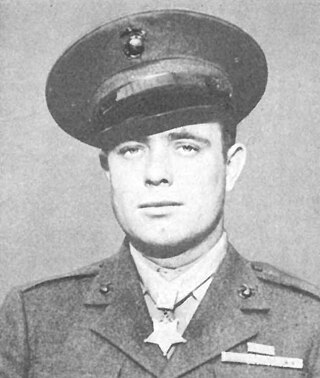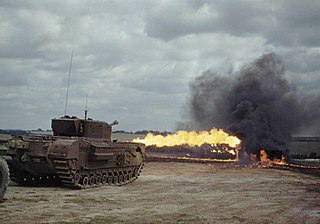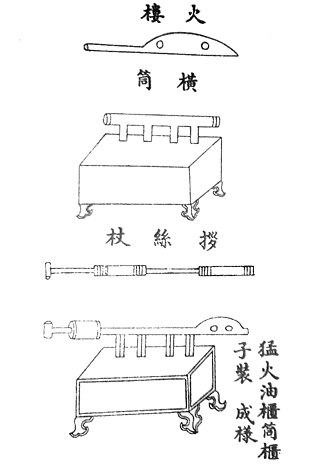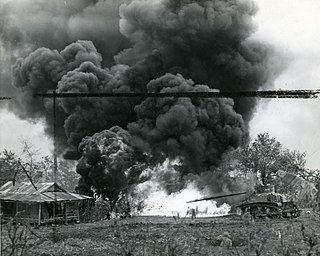
A flamethrower is a ranged incendiary device designed to project a controllable jet of fire. First deployed by the Byzantine Empire in the 7th century AD, flamethrowers saw use in modern times during World War I, and more widely in World War II as a tactical weapon against fortifications.
A frog is a member of a diverse group of amphibians composing the order Anura.
A wasp is a type of flying insect.
M1A1, M1-A1, M1 A1, or M-1A1 may refer to:

A flame tank is a type of tank equipped with a flamethrower, most commonly used to supplement combined arms attacks against fortifications, confined spaces, or other obstacles. The type only reached significant use in the Second World War, during which the United States, Soviet Union, Germany, Italy, Japan, and the United Kingdom all produced flamethrower-equipped tanks.

The M2 flamethrower was an American, man-portable, backpack flamethrower that was used in World War II, the Korean War, and the Vietnam War. The M2 was the successor to the M1 and M1A1 flamethrowers. Although its burn time was around 7 seconds long, and the flames were effective around 20–40 meters, it was still a useful weapon. With the arrival of flamethrower tanks, the need for flamethrower-carrying infantrymen to expose themselves to enemy fire had been greatly reduced.

The Type 93 and Type 100 flamethrowers were flamethrowers used by the Imperial Japanese Army and Imperial Japanese Navy's SNLF during the Second Sino-Japanese War and World War II.

The Flamethrower, Portable, No 2, also known as the Ack Pack, was a British design of flamethrower for infantry use in the Second World War.

The "Ronson" flamethrower was developed for mechanized applications during World War II and used by the Canadian Army and the United States Marine Corps.

Hershel Woodrow "Woody" Williams was a United States Marine Corps Reserve warrant officer and United States Department of Veterans Affairs veterans service representative who received the Medal of Honor, the United States military's highest decoration for valor, for heroism above and beyond the call of duty during the Battle of Iwo Jima in World War II. Williams was the last living Medal of Honor recipient from World War II.

The Carro Veloce 33 (CV 33) or L3/33 was a tankette originally built in 1933 and used by the Italian Army before and during World War II. It was based on the imported British Carden Loyd tankette. Many CV 33s were retrofitted to meet the specifications of the CV 35 in 1935. In 1938, the CV 33 was renamed the "L3/33" while the CV 35 became the "L3/35s."

The Lagonda company produced a number of flamethrowers during the Second World War.

The Churchill Crocodile was a British flame-throwing tank of late Second World War. It was a variant of the Tank, Infantry, Mk IV (A22) Churchill Mark VII, although the Churchill Mark IV was initially chosen to be the base vehicle.

The Fierce-fire Oil Cabinet was a double-piston pump naphtha flamethrower first recorded to have been used in 919 AD in China, during the Five Dynasties and Ten Kingdoms period.

The ROKS-2 and ROKS-3 were man-portable flamethrowers used by the USSR in the Second World War.

The M1 and M1A1 were portable flamethrowers developed by the United States during World War II. The M1 weighed 72 lb, had a range of 15 meters, and had a fuel tank capacity of five gallons. The improved M1A1 weighed less, at 65 lb, had a much longer range of 45 meters, had the same fuel tank capacity, and fired thickened fuel (napalm).
The Petroleum Warfare Department (PWD) was a government department established in Britain in 1940 in response to the invasion crisis during World War II, when Germany apparently would invade the country. The department was initially tasked with developing the uses of petroleum as a weapon of war, and it oversaw the introduction of a wide range of flame warfare weapons. Later in the war, the department was instrumental in the creation of the Fog Investigation and Dispersal Operation that cleared runways of fog allowing the landing of aircraft returning from bombing raids over Germany in poor visibility, and Operation Pluto, which installed prefabricated fuel pipelines between England and France soon after the Allied invasion of Normandy in June 1944.

The Flammenwerfer 41, or FmW 41 was the standard German flamethrower beginning in 1941 and an upgraded version of the earlier Flammenwerfer 35, whose main issue was its excessive weight of 36kg, with the Flammenwerfer 41 being only 18. It performed a similar role of other flamethrowers of the time, namely clearing enemy trenches and buildings in highly fortified areas. From 1942 to April 1945, 64,284 examples were produced. After 1945, flamethrowers gradually saw less usage, and the Bundeswehr does not use any.

During WWII United States Naval Construction Battalions ("Seabees") modified/created all of the main armament flame throwing tanks that were used in the Pacific War: by USMC in the Battle of Saipan, Battle of Tinian, Battle of Iwo Jima, and by the U.S. Army in the Battle of Okinawa.

When WWII broke the United States had no mechanized flamethrowing capability. It is believed that an officer in the 754th U.S. Army tank battalion came up with the idea of mounting a flame thrower on a M3 Light tank on the island of New Caledonia. The Army used the idea on New Georgia and the Marines during the Battle of Bougainville. After which further development passed to the U.S. Army. Chemical Warfare Service at Schofield Barracks, Territory of Hawaii. There the Army reached out to the United States Naval Construction Force for assistance. The Seabees accepted the offer and converted or modified nearly 400 tanks for the Army. Those weapons set the standard for the U.S. through the Korean War. It was not until 1955 that a superior flame throwing tank replaced the Shermans the Seabees created.















